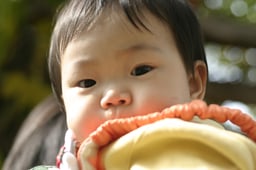Infant
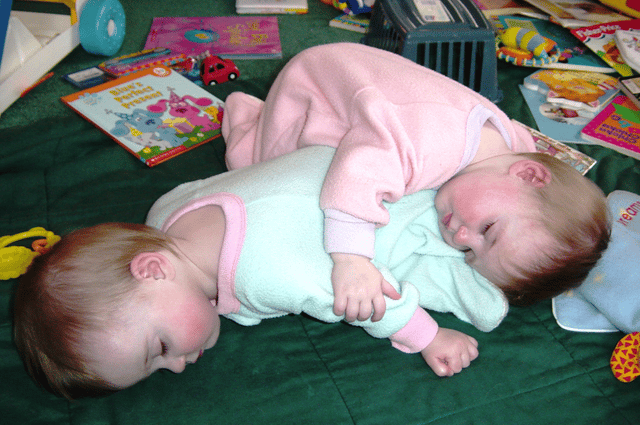
Infant
An infant (from the Latin word infans, meaning "unable to speak" or "speechless") is the more formal or specialised synonym for "baby", the very young offspring of a human. The term may also be used to refer to juveniles of other organisms.
A newborn is, in colloquial use, an infant who is only hours, days, or up to one month old. In medical contexts, newborn or neonate (from Latin, neonatus, newborn) refers to an infant in the first 28 days after birth;[1] the term applies to premature, full term, and postmature infants; before birth, the term "fetus" is used. The term "infant" is typically applied to young children under one year of age; however, definitions may vary and may include children up to two years of age. When a human child learns to walk, the term "toddler" may be used instead.
In British English, an infant school is for children aged between four and seven. As a legal term, "infancy" continues from birth until age 18.[2]
Physical characteristics of newborn

(video) A very young baby moves around in a crib, 2009

Eight month-old infant; as a common feature eyes are usually large in relation to the face.

A crying newborn, a few days after birth
A newborn's shoulders and hips are wide, the abdomen protrudes slightly, and the arms and legs are relatively long with respect to the rest of their body.
Length
In first world nations, the average total body length of newborns are 35.6–50.8 cm (14.0–20.0 in), although premature newborns may be much smaller.
Ways to measure a baby's length is to lay him down and stretch a measuring tape from the top of his head to the bottom of his heel.
Measure the circumference of your baby's head also.
Weight
In developed countries, the average birth weight of a full-term newborn is approximately 3.4 kg (7 1⁄2 lb), and is typically in the range of 2.7–4.6 kg (6.0–10.1 lb).
Over the first 5–7 days following birth, the body weight of a term neonate decreases by 3–7%,[3] and is largely a result of the resorption and urination of the fluid that initially fills the lungs, in addition to a delay of often a few days before breastfeeding becomes effective. After the first week, healthy term neonates should gain 10–20 grams/day.[3]
Head
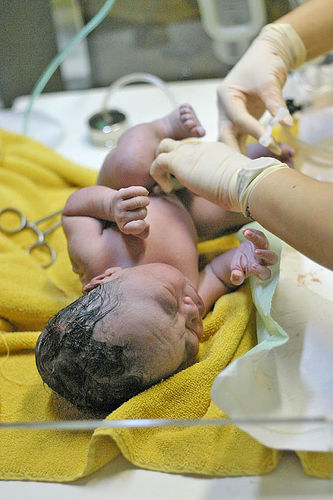
A newborn baby in Indonesia, with umbilical cord ready to be clamped
A newborn's head is very large in proportion to the body, and the cranium is enormous relative to his or her face. While the adult human skull is about one seventh of the total body length, the newborn's is about ¼. Normal head circumference for a full-term infant is 33–36 cm at birth.[4] At birth, many regions of the newborn's skull have not yet been converted to bone, leaving "soft spots" known as fontanels. The two largest are the diamond-shaped anterior fontanel, located at the top front portion of the head, and the smaller triangular-shaped posterior fontanel, which lies at the back of the head. Later in the child's life, these bones will fuse together in a natural process. A protein called noggin is responsible for the delay in an infant's skull fusion.[5]
During labour and birth, the infant's skull changes shape to fit through the birth canal, sometimes causing the child to be born with a misshapen or elongated head. It will usually return to normal on its own within a few days or weeks. Special exercises sometimes advised by physicians may assist the process.
Hair
Some newborns have a fine, downy body hair called lanugo. It may be particularly noticeable on the back, shoulders, forehead, ears and face of premature infants. Lanugo disappears within a few weeks. Infants may be born with full heads of hair; others, particularly caucasian infants, may have very fine hair or may even be bald. Amongst fair-skinned parents, this fine hair may be blonde, even if the parents are not. Infants hair color and texture change. Red can give way to blond. Curly can go straight and baby's thick, dark hair could make its reappearance a lot sparser and lighter. The scalp may also be temporarily bruised or swollen, especially in hairless newborns, and the area around the eyes may be puffy.
Skin
Immediately after birth, a newborn's skin is often grayish to dusky blue in color.
As soon as the newborn begins to breathe, usually within a minute or two, the skin's color reaches its normal tone.
Newborns are wet, covered in streaks of blood, and coated with a white substance known as vernix caseosa, which is hypothesised to act as an antibacterial barrier. The newborn may also have Mongolian spots, various other birthmarks, or peeling skin, particularly on the wrists, hands, ankles, and feet.
Genitals
A newborn's genitals are enlarged and reddened, with male infants having an unusually large scrotum. The breasts may also be enlarged, even in male infants. This is caused by naturally occurring maternal hormones and is a temporary condition. Females (and even males) may actually discharge milk from their nipples (sometimes called witch's milk), or a bloody or milky-like substance from the vagina. In either case, this is considered normal and will disappear with time.
Umbilical cord
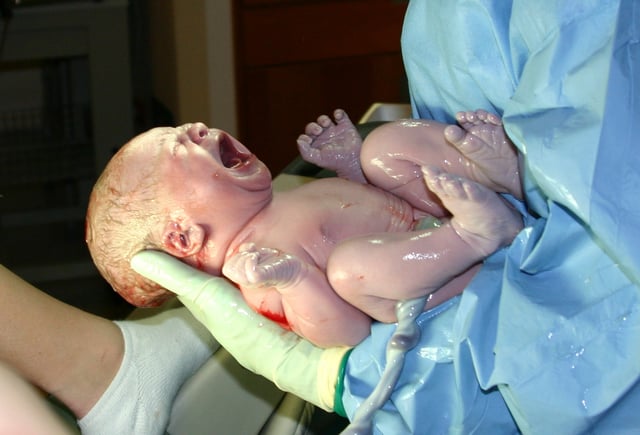
A newborn infant, seconds after delivery.
The umbilical cord of a newborn is bluish-white in color. After birth, the umbilical cord is normally cut, leaving a 1–2 inch stub. The umbilical stub will dry out, shrivel, darken, and spontaneously fall off within about 3 weeks. This will later become a belly-button after it heals. Occasionally, hospitals may apply triple dye to the umbilical stub to prevent infection, which may temporarily color the stub and surrounding skin purple.
The umbilical cord contains three vessels: two arteries and one vein.
The two arteries carry blood from the baby to the placenta while one vein carries blood back to the baby.
Care and feeding
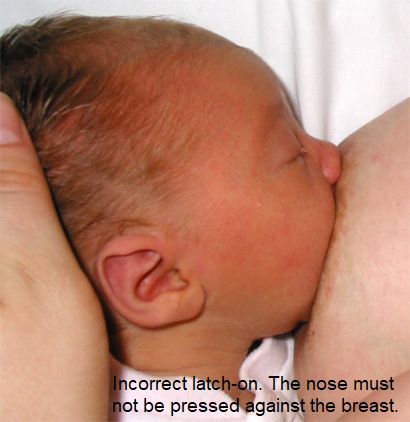
A baby breastfeeding
Infants cry as a form of basic instinctive communication.[6] A crying infant may be trying to express a variety of feelings including hunger, discomfort, overstimulation, boredom, wanting something, or loneliness.
Breastfeeding is the recommended method of feeding by all major infant health organizations.[7] If breastfeeding is not possible or desired, bottle feeding is done with expressed breast-milk or with infant formula. Infants are born with a sucking reflex allowing them to extract the milk from the nipples of the breasts or the nipple of the baby bottle, as well as an instinctive behavior known as rooting with which they seek out the nipple. Sometimes a wet nurse is hired to feed the infant, although this is rare, especially in developed countries.
Adequate food consumption at an early age is vital for an infant’s development.
The foundations of optimum health, growth, and neurodevelopment across the lifespan are established in the first 1000 days of life.[8] From birth to four months, infants should consume breast milk or an unmodified milk substitute.
As an infant’s diet matures, finger foods may be introduced as well as fruit, vegetables and small amounts of meat.[9]
As infants grow, food supplements are added.
Many parents choose commercial, ready-made baby foods to supplement breast milk or formula for the child, while others adapt their usual meals for the dietary needs of their child. Whole cow's milk can be used at one year, but lower-fat milk is not recommended until the child is 2 to 3 years old. Weaning is the process through which breast milk is eliminated from the infant's diet through the introduction of solid foods in exchange for milk.[10] Until they are toilet-trained, infants in industrialized countries wear diapers. The transition from diapers to training pants is an important transition in the development of an infant/baby to that of a toddler. Children need more sleep than adults—up to 18 hours for newborn babies, with a declining rate as the child ages. Until babies learn to walk, they are carried in the arms, held in slings or baby carriers, or transported in baby carriages or strollers. Most industrialized countries have laws requiring child safety seats for babies in motor vehicles.
Response to sounds
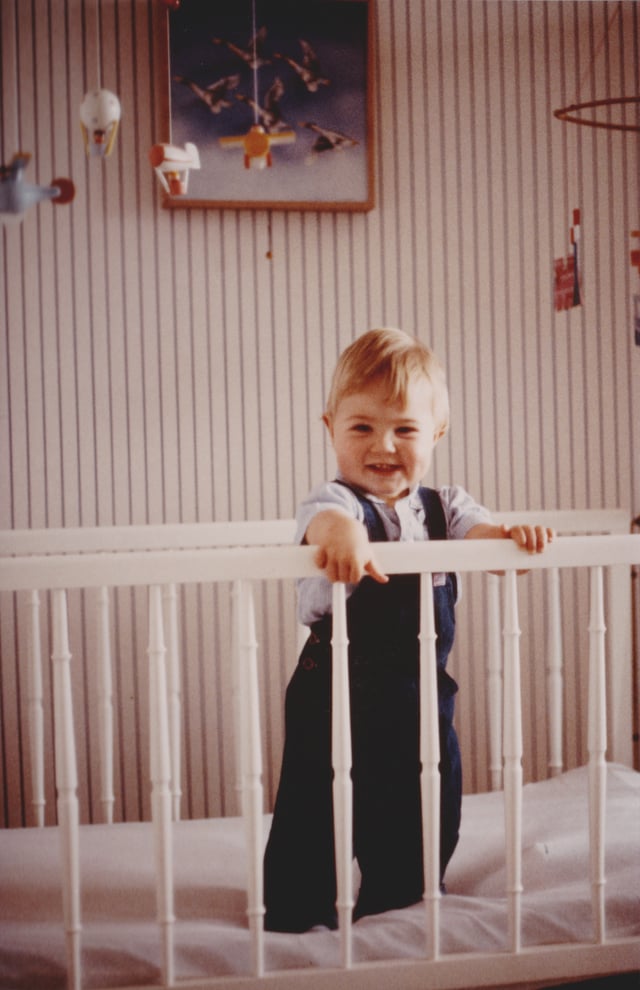
Baby standing in bed - 1983
Infants respond to the sound of snake hissing, angry voices of adults, the crackling sound of a fire, thunder, and the cries of other infants.
They have a drop in heart rate, their eyes blinking, increased turning toward the speakers or parent, all of these indicating that they were paying more attention.
This is believed by some to be evolutionary response to danger.
Babies' ability to accurately locate sounds is refined during their first year.[11]
Benefits of touch
Studies have shown that infants who have been the recipients of positive touch experience more benefits as they develop emotionally and socially.
Experiments have been done with infants up to four months of age using both positive touch (stroking or cuddling) and negative touch (poking, pinching or tickling).
The infants who received the positive touch cried less often and also vocalized and smiled more than the infants who were touched negatively.
Infants who were the recipients of negative touching have been linked with emotional and behavioral problems later in life.
A lower amount of physical violence in adults has been discovered in cultures with greater levels of positive physical touching.[12]
Diseases
The infant is undergoing many adaptations to extrauterine life, and its physiological systems, such as the immune system, are far from fully developed. Potential diseases of concern during the neonatal period include:
Neonatal jaundice
Infant respiratory distress syndrome
Neonatal lupus erythematosus
Neonatal conjunctivitis
Neonatal tetanus
Neonatal sepsis
Neonatal bowel obstruction
Benign neonatal seizures
Neonatal diabetes mellitus
Neonatal alloimmune thrombocytopenia
Neonatal herpes simplex
Neonatal hemochromatosis
Neonatal meningitis
Neonatal hepatitis
Neonatal hypoglycemia
Mortality

An infant being immunized in Bangladesh
Infant mortality is the death of an infant in the first year of life, often expressed as the number of deaths per 1000 live births (infant mortality rate).
Major causes of infant mortality include dehydration, infection, congenital malformation and SIDS.[13]
This epidemiological indicator is recognized as a very important measure of the level of health care in a country because it is directly linked with the health status of infants, children, and pregnant women as well as access to medical care, socioeconomic conditions, and public health practices.[14][15]
There is a positive relationship between national wealth and good health.
The rich and industrialized countries of the world, prominently Canada, the United Kingdom, the United States, and Japan, spend a large proportion of their wealthy budget on the health care system.
As, a result, their health care systems are very sophisticated, with many physicians, nurses, and other health care experts servicing the population.
Thus, infant mortality is low.
On the other hand, a country such as Mexico, which spends disproportionately less of its budget on healthcare, suffers from high mortality rates.
This is because the general population is likely to be less healthy.[16] In the U.S., infant mortality rates are especially high in minority groups. For instance, non-Hispanic black women have an infant mortality rate of 13.63 per 1000 live births whereas in non-Hispanic white women it was much lower at a rate of 5.76 per 1000 live births.[17] The average infant mortality rate in the U.S. is 6.8 per 1000 live births. [18]
Emotional development

A mother wishes joy towards her child in William Blake's poem "Infant Joy". This copy, Copy AA, was printed and painted in 1826, is currently held by the Fitzwilliam Museum.[19]
Attachment theory is primarily an evolutionary and ethological theory whereby the infant or child seeks proximity to a specified attachment figure in situations of alarm or distress for the purpose of survival.[20] The forming of attachments is considered to be the foundation of the infant/child's capacity to form and conduct relationships throughout life. Attachment is not the same as love or affection although they often go together. Attachment and attachment behaviors tend to develop between the age of 6 months and 3 years. Infants become attached to adults who are sensitive and responsive in social interactions with the infant, and who remain as consistent caregivers for some time. Parental responses lead to the development of patterns of attachment, which in turn lead to 'internal working models' which will guide the individual's feelings, thoughts, and expectations in later relationships.[21] There are a number of attachment 'styles' namely 'secure', 'anxious-ambivalent', 'anxious-avoidant', (all 'organized') and 'disorganized', some of which are more problematic than others. A lack of attachment or a seriously disrupted capacity for attachment could potentially amount to serious disorders.[22]
Babyhood
Plane travel
Many airlines refuse boarding for all babies aged under 7 days (for domestic flights) or 14 days for international flights. Asiana Airlines allows babies to board international flights at 7 days of age. Garuda Indonesia disallows all babies under the age of 14 days to board any flights.
Delta Air Lines allows infants to travel when they are less than 7 days old when they present a physician travel approval letter. Skywest will not allow an infant less than 8 days old on board.[28]
